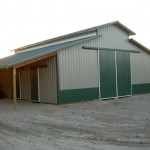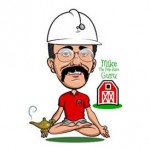It was a pleasant October evening back in 1985 in Blacksburg, Virginia. My friend Dr. Frank Woeste was then a professor in the College of Agricultural and Life Sciences at Virginia Tech (officially Virginia Polytechnic Institute and State University) and he had invited me to teach one of his classes for a day, in exchange for him providing some basic engineering software which would design post frame building columns, roof purlins and wall girts.
Now back in 1985, Virginia Tech had not yet become the NCAA football powerhouse it grew into under the direction of Hokies’ head coach Frank Beamer – having now participated in post season bowl games for each of the last 23 seasons. This also long predated the April 16, 2007 tragedy in which Virginia Tech student Seung-Hui Cho fatally shot 32 faculty members and students, wounding 17 others before killing himself on campus. This shooting remains the deadliest mass shooting committed by a lone gunman in United States history.
Mid-way through the evening with Frank, after digesting a hearty meal and debating whether the hops in the liquid consumed were a fruit or a vegetable (they actually are neither – they are flower cones), we digressed into the true essence of Dr. Woeste’s research at Virginia Tech – which was post frame buildings and prefabricated metal connector plated wood trusses.
Narrowing things down, a lively discussion occurred (including some of his grad students) on whether steel roofing and siding for post frame buildings should be attached with screws through the ‘flats’ or on the tops of the high ribs.
For years steel roofing and siding had been attached with ring shanked nails (read more about this and Dr. Woeste here: https://www.hansenpolebuildings.com/2011/12/ring-shank-nails/). The traditional location of the nails was at the crown of the high ribs – knowing not all of the nails would be identically driven through the steel into the underlying wood. The concept was rain running off the roof would never get high enough to leak around the improperly seated nails on the tops of the high ribs!
So, what would happen if screws were improperly placed in the crowns of the steel high ribs?
Properly designed post frame buildings are dependent upon the diaphragm action contributed by the skin (roofing and siding) and numerous tests have been done to confirm the shear strength of the panels as properly fastened. When screws are placed through the high ribs, there is a 5/8 to ¾ inch gap between the underside of the high rib and the framing below. The screw can flex within this space, reducing the shear load carrying capacity of the sheathing system.
Furthermore, the flexation of the screws in this gap, allows the steel panels to move slightly under wind or seismic loads, eventually contributing to slots being formed in the steel around the screw shanks, and over time, causing leaks.
The answer Frank and I came up with is the same one espoused by every steel roofing and siding roll former – screw in the flats, not on the ribs!









I replaced a roof that had WW2 era metal on it. 100′ barn that was leaking terribly. As stated above, each of the nail holes had wiggled a good size hole (over 80 years). Having done several metal roofs since then I would say if you are an amateur, screw on the flat with 1 1/2″ screws. I strap all roofs with nothing less than 2×4 to help lock that roof in place. Screwing high on the rib is difficult for the amateur. Pay attention to not squishing the washer or leaving it too loose. All that being said I often think of the words of my grandfatherwho said “it’ll do me out”. Do it however you want, it’ll probably be okay
Steel manufacturers recommend screws in the flats in all cases.
you are dead wrong and if you have installed enough of these over time you will not be installing on the flats… its bad practice
Having only been installing threw screwed steel panels with screws in the flats for over 40 years, I will respectfully disagree.
they do not. scotia steel expects rib screws when on a roof, flats when on a wall….. same as every other manufacturer.
Scotia does not have installation instructions on their website. I have reached out to them, but have not gotten a response. Roll formers in the U.S. do show screws in flats for both roof and wall applications.
VicWest, a Canadian steel roofing company, recommends screws in the ribs of all sheeted products.
I am looking at Page 3 of the Ultra Vic installation guide and it shows “structural fasteners in flat of panel”.
Those of us who have been in roofing for a long time around here in Chatham, NC, generally will agree that the manufactures recommend screws in the flats because they want repeat business, I can show you a good 5V crimped roof, nailed in the ridges with acorn nails, that’s been abandoned in the woods for over fifty years, when I first saw it. My guess is that an outfit named Budd Piper installed that roof in the 1920s or 30s. Newspaper adds from the 1920s in our county offer 5V for barns and sheds. Folks quickly figured out that 5V was good for houses also. There’s not a shred of zinc left on that old roof, but that low carbon, heavier gauge steel is doing nicely. Nowadays, metal roofs come with a ten-year guarantee. ten years is about how long the rubber washers on the screws will last. Roofers are starting to have to replace the fasteners on roofs installed since the manufactures started recommending fasteners in the flats. No wonder roofers are a cynical lot.
I don’t know what sort of steel roofing you are buying with only a 10 year warranty – most panels we provide are 40 years to lifetime. Neoprene rubber gaskets are problematic however, as they are not UV resistant. Only screws with EPDM gaskets should be used – our manufacturer guarantees their screws will outlast the steel roofing they are installed in.
so I will tell you this from experience. Manufactures want you to screw on the flat for 2 reasons. It is easier to get a proper layment of the panel and they want to sell their newer more expensive products. If you are experienced enough you can place the screws properly on the rib and this is the best way to go for many reasons. As he stated the roof flexes and moves. with the screws on the rib it allows the roof to flex. On the flat it causes far more resistance to flex and will cause the screws to either back out. damage the washers or even break the screw heads off. When going through the rib I use 2 inch screws to solve the issues he demonstrated. when on the rib pre drilling helps prevent problems. If you have a faulty screw on the rib will leak 99 percent less than a faulty screw on the flat. I predrill only on the laps and trim pieces. I started putting through the roof on the threads of the screws just after they penetrate the metal. Do this right and your screws will remain water tight for over 60 years,,, do it on the flat and I can guarantee you are replacing most of them in under 20 years. Also never install exposed fastener panels without purlins except in buildings that are not heated. NEVER. I have repaired so many roofs that were screwed on the flat….
Screwing through the high ribs negates nearly all of the shear resistance that would otherwise be gained by screws in the flats. Screws on the ribs will allow the screw shanks to deform between purlin and roof steel. This deformation will eventually lead to slots forming under the screw heads and eventually leaks. Properly installed, #12 or 14 diameter 1-1/2″ long screws with EPDM gaskets below the grommets will not back out, washers will not fail and heads will not shear off. Having provided and/or installed tens of millions of screws in this fashion, the proof of success is in the lack of issues from them.